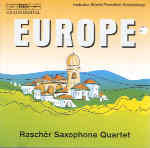A saxophone quartet? Nothing but four saxophones for an entire hour? That’s the premise of “Europe”–and with these players at the helm it’s quite an hour indeed. The roster of composers associated with this ensemble is impressive; by their count, more than 250 composers have written for them. All five works presented here are associated with the quartet in some way, and the Hindemith, Nørgård, and Halffter are all world-premiere recordings. Xenakis’ Xas (which typographically should have the “s” backwards, for what it’s worth), Nørgård’s Roads to Ixtlan, and Halffter’s Fractal were all written for the quartet; Hindemith’s Konzertstück was written at the behest of the late Sigurd Raschèr, one of the last century’s leading players who was a founding member of the ensemble that carries his name. Penderecki himself suggested the arrangement of his quartet after hearing the group play at Schleswig-Holstein.
One listen to this disc proves that this notable group of composers was not attracted to the Raschèr players just for novelty’s sake: these are extraordinary players, whose seamless sense of ensemble and pure tone are startling, as is their precise articulation and verve. These are incredibly diverse works, given that the Raschèrs’ instruments are more commonly associated with jazz than with European art music. Nørgård’s Roads to Ixtlan is the closest to jazz: despite the title’s association with Mexico, his piece encompasses a technical sphere that brings Ornette Coleman to mind, with its explorations of the top and bottom of the saxophones’ tonal ranges. (The general arrangement is Carina Raschèr on soprano, Harry-Kinross White on alto, Bruce Weinberger on tenor, and Kenneth Coon on bass.)
Hindemith’s Konzertstück, written in 1933 but premiered only in 1964 by the Raschèr father-daughter duo, also plays with the fluid lines between European classical music and jazz and alternates between sharp, angular phrases and sustained lyrical lines that recall the human voice. Halffter’s Fractals is the least cohesive of the bunch. As this work was extracted from the German/Spanish composer’s Concierto a Cuatro for four saxophones and orchestra (it’s simply the soloists’ parts), perhaps that condition is understandable, but it feels as if something is missing–that is, a form around which to shape its flurries of notes.
The Xenakis generally moves in a much smaller frame, with simple scale-based movements that put the players in such close tonal proximity that it promotes a sense of heterophony. Penderecki’s Quartet, inspired by the Schubert String Quintet, is immediately recognizable as his style, with long periods of suggested stillness familiar to fans of the Second Symphony. The sound is quite good, very sharply defined and clear. Regardless of the quirkiness of their setup, these players deserve to take their place in the top tier of contemporary chamber ensembles. For those hankering to seek out more, this recording is something of a companion to another BIS release featuring the same players, titled “America”. [8/5/2002]
































